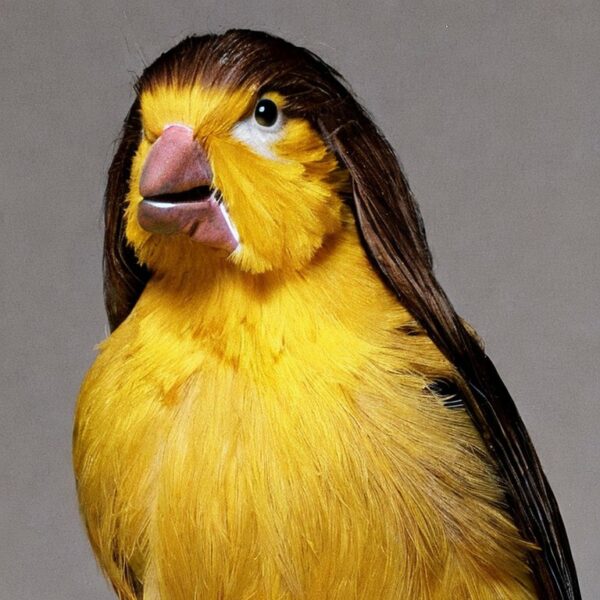Introduction: The integumentary structures of birds and mammals have intrigued evolutionary biologists for years. A significant query involves the evolutionary relationship between feathers in birds and hair in mammals. Both feathers and hair are keratinous structures that provide insulation, camouflage, and facilitate social signaling. This article dissects the morphogenetic pathways and molecular evidence behind the evolutionary kinship between feathers and hair.
Origins and Evolutionary Divergence: Feathers and hair have distinct evolutionary origins. Though there is still quite a lot of debate amongst experts, the development of feathers can be traced back to the theropod dinosaurs whereas hair emerged in the mammalian lineage. Dinosaurs evolved from a group of reptiles known as archosaurs. In contrast, the first mammals evolved from a group of extinct creatures known as synapsids that first appeared around 312 million years ago. Over time, certain synapsids developed more mammalian characteristics, including hair, and these mammal-like synapsids are termed as therapsids.
The earliest feathers that can be found in the fossil record were simple filamentous structures, similar to hair, which later diversified into complex branching patterns in birds. It has been suggested that the feather’s complex branching pattern is an elaboration of the single filament seen in hair, indicative of a common ancestral trait. Though it is quite debatable, it has been suggested that teeth, dermal scales, epidermal scales, feathers, and hair all simultaneously evolved from a common skin placode and dermal cell structure that was present in an ancestral early vertebrate gnathostome (a vertebrate with a jaw), equipped with odontodes (dermal teeth), approximately 420 million years ago.
Morphogenetic Similarities: Recent studies have shed light on the morphological similarities between feathers and hair. Both structures arise from placodes – thickenings of the skin epidermis with underlying dermal papillae. The epithelial placodes invaginate to form follicles, where keratinocyte cell proliferation takes place. The cells differentiate and migrate upwards, synthesizing keratin proteins to form the hair shaft or feather vane as appropriate. The resemblance in development suggests that feathers and hair share a conserved morphogenetic pathway.
Molecular Commonalities: At the molecular level, the involvement of key signaling pathways such as Wnt, BMP (Bone Morphogenetic Protein), and SHH (Sonic Hedgehog) are shared between feather and hair development. These pathways regulate the formation and differentiation of placodes. Additionally, the keratin proteins that constitute feathers and hair are encoded by genes belonging to the same family, the β-keratin gene family. A noteworthy finding is that certain genes involved in feather development, such as FGF5 and CTNNB1, are also implicated in hair development, suggesting evolutionary conservation at the genetic level.
Functional Convergence: Despite their distinct evolutionary origins, feathers and hair have evolved to perform similar functions, such as thermoregulation, camouflage, and sensory perception. For example, contour feathers in birds and fur in mammals serve to trap air, providing insulation against temperature fluctuations. Moreover, both feathers and hair are implicated in mate selection, where color patterns and structures are used for display and mate attraction. This illustrates a case of convergent evolution, where distinct lineages evolve similar traits in response to analogous environmental pressures.
Constraints and Diversification: Evolutionary constraints have influenced the diversification of feathers and hair. While feathers have evolved a diverse range of forms, from downy insulating feathers to the flight feathers of bird wings, mammalian hair remains relatively simple in structure. It is speculated that the early evolution of complex branching in feathers unlocked a plethora of adaptive possibilities, whereas the relative simplicity of hair constrained its diversification. However, the specialized modifications in mammalian hair, such as quills in porcupines and scales in pangolins, demonstrate the adaptive versatility within these constraints.
Conclusion: The evolutionary relationship between feathers and hair is marked by shared morphogenetic pathways and molecular mechanisms, indicative of a deep evolutionary kinship. Though feathers and hair have distinct origins and have undergone different evolutionary trajectories, the conservation in their development and analogous functions suggest an intricate interplay of evolutionary forces. Further research into the genetic and developmental mechanisms could provide deeper insights into the evolutionary history and diversification of these remarkable integumentary structures.
Bibliography
11711645 {11711645:PVBTF77Z},{11711645:JJZ55TB5},{11711645:WAA4SQAX},{11711645:NRXEB9EA},{11711645:8ZZ5ZDF8},{11711645:XRZQ28R4} 1 vancouver 50 date asc 221 https://www.keratin.com/wp-content/plugins/zotpress/ %7B%22status%22%3A%22success%22%2C%22updateneeded%22%3Afalse%2C%22instance%22%3Afalse%2C%22meta%22%3A%7B%22request_last%22%3A0%2C%22request_next%22%3A0%2C%22used_cache%22%3Atrue%7D%2C%22data%22%3A%5B%7B%22key%22%3A%22NRXEB9EA%22%2C%22library%22%3A%7B%22id%22%3A11711645%7D%2C%22meta%22%3A%7B%22creatorSummary%22%3A%22Sawyer%20and%20Knapp%22%2C%22parsedDate%22%3A%222003-08-15%22%2C%22numChildren%22%3A0%7D%2C%22bib%22%3A%22%3Cdiv%20class%3D%5C%22csl-bib-body%5C%22%20style%3D%5C%22line-height%3A%201.35%3B%20%5C%22%3E%5Cn%20%20%3Cdiv%20class%3D%5C%22csl-entry%5C%22%20style%3D%5C%22clear%3A%20left%3B%20%5C%22%3E%5Cn%20%20%20%20%3Cdiv%20class%3D%5C%22csl-left-margin%5C%22%20style%3D%5C%22float%3A%20left%3B%20padding-right%3A%200.5em%3B%20text-align%3A%20right%3B%20width%3A%201em%3B%5C%22%3E1.%3C%5C%2Fdiv%3E%3Cdiv%20class%3D%5C%22csl-right-inline%5C%22%20style%3D%5C%22margin%3A%200%20.4em%200%201.5em%3B%5C%22%3ESawyer%20RH%2C%20Knapp%20LW.%20Avian%20skin%20development%20and%20the%20evolutionary%20origin%20of%20feathers.%20J%20Exp%20Zool%20B%20Mol%20Dev%20Evol.%202003%20Aug%2015%3B298%281%29%3A57%26%23x2013%3B72.%3C%5C%2Fdiv%3E%5Cn%20%20%20%3C%5C%2Fdiv%3E%5Cn%3C%5C%2Fdiv%3E%22%2C%22data%22%3A%7B%22itemType%22%3A%22journalArticle%22%2C%22title%22%3A%22Avian%20skin%20development%20and%20the%20evolutionary%20origin%20of%20feathers%22%2C%22creators%22%3A%5B%7B%22creatorType%22%3A%22author%22%2C%22firstName%22%3A%22Roger%20H.%22%2C%22lastName%22%3A%22Sawyer%22%7D%2C%7B%22creatorType%22%3A%22author%22%2C%22firstName%22%3A%22Loren%20W.%22%2C%22lastName%22%3A%22Knapp%22%7D%5D%2C%22abstractNote%22%3A%22The%20discovery%20of%20several%20dinosaurs%20with%20filamentous%20integumentary%20appendages%20of%20different%20morphologies%20has%20stimulated%20models%20for%20the%20evolutionary%20origin%20of%20feathers.%20In%20order%20to%20understand%20these%20models%2C%20knowledge%20of%20the%20development%20of%20the%20avian%20integument%20must%20be%20put%20into%20an%20evolutionary%20context.%20Thus%2C%20we%20present%20a%20review%20of%20avian%20scale%20and%20feather%20development%2C%20which%20summarizes%20the%20morphogenetic%20events%20involved%2C%20as%20well%20as%20the%20expression%20of%20the%20beta%20%28beta%29%20keratin%20multigene%20family%20that%20characterizes%20the%20epidermal%20appendages%20of%20reptiles%20and%20birds.%20First%20we%20review%20information%20on%20the%20evolution%20of%20the%20ectodermal%20epidermis%20and%20its%20beta%20%28beta%29%20keratins.%20Then%20we%20examine%20the%20morphogenesis%20of%20scutate%20scales%20and%20feathers%20including%20studies%20in%20which%20the%20extraembryonic%20ectoderm%20of%20the%20chorion%20is%20used%20to%20examine%20dermal%20induction.%20We%20also%20present%20studies%20on%20the%20scaleless%20%28sc%29%20mutant%2C%20and%2C%20because%20of%20the%20recent%20discovery%20of%20%5C%22four-winged%5C%22%20dinosaurs%2C%20we%20review%20earlier%20studies%20of%20a%20chicken%20strain%2C%20Silkie%2C%20that%20expresses%20ptilopody%20%28pti%29%2C%20%5C%22feathered%20feet.%5C%22%20We%20conclude%20that%20the%20ability%20of%20the%20ectodermal%20epidermis%20to%20generate%20discrete%20cell%20populations%20capable%20of%20forming%20functional%20structural%20elements%20consisting%20of%20specific%20members%20of%20the%20beta%20keratin%20multigene%20family%20was%20a%20plesiomorphic%20feature%20of%20the%20archosaurian%20ancestor%20of%20crocodilians%20and%20birds.%20Evidence%20suggests%20that%20the%20discrete%20epidermal%20lineages%20that%20make%20up%20the%20embryonic%20feather%20filament%20of%20extant%20birds%20are%20homologous%20with%20similar%20embryonic%20lineages%20of%20the%20developing%20scutate%20scales%20of%20birds%20and%20the%20scales%20of%20alligators.%20We%20believe%20that%20the%20early%20expression%20of%20conserved%20signaling%20modules%20in%20the%20embryonic%20skin%20of%20the%20avian%20ancestor%20led%20to%20the%20early%20morphogenesis%20of%20the%20embryonic%20feather%20filament%2C%20with%20its%20periderm%2C%20sheath%2C%20and%20barb%20ridge%20lineages%20forming%20the%20first%20protofeather.%20Invagination%20of%20the%20epidermis%20of%20the%20protofeather%20led%20to%20formation%20of%20the%20follicle%20providing%20for%20feather%20renewal%20and%20diversification.%20The%20observations%20that%20scale%20formation%20in%20birds%20involves%20an%20inhibition%20of%20feather%20formation%20coupled%20with%20observations%20on%20the%20feathered%20feet%20of%20the%20scaleless%20%28High-line%29%20and%20Silkie%20strains%20support%20the%20view%20that%20the%20ancestor%20of%20modern%20birds%20may%20have%20had%20feathered%20hind%20limbs%20similar%20to%20those%20recently%20discovered%20in%20nonavian%20dromaeosaurids.%20And%20finally%2C%20our%20recent%20observation%20on%20the%20bristles%20of%20the%20wild%20turkey%20beard%20raises%20the%20possibility%20that%20similar%20integumentary%20appendages%20may%20have%20adorned%20nonavian%20dinosaurs%2C%20and%20thus%20all%20filamentous%20integumentary%20appendages%20may%20not%20be%20homologous%20to%20modern%20feathers.%22%2C%22date%22%3A%222003-08-15%22%2C%22language%22%3A%22eng%22%2C%22DOI%22%3A%2210.1002%5C%2Fjez.b.26%22%2C%22ISSN%22%3A%221552-5007%22%2C%22url%22%3A%22%22%2C%22collections%22%3A%5B%226FKFH29D%22%5D%2C%22dateModified%22%3A%222023-06-23T13%3A33%3A09Z%22%7D%7D%2C%7B%22key%22%3A%22JJZ55TB5%22%2C%22library%22%3A%7B%22id%22%3A11711645%7D%2C%22meta%22%3A%7B%22creatorSummary%22%3A%22Dhouailly%22%2C%22parsedDate%22%3A%222009-04%22%2C%22numChildren%22%3A0%7D%2C%22bib%22%3A%22%3Cdiv%20class%3D%5C%22csl-bib-body%5C%22%20style%3D%5C%22line-height%3A%201.35%3B%20%5C%22%3E%5Cn%20%20%3Cdiv%20class%3D%5C%22csl-entry%5C%22%20style%3D%5C%22clear%3A%20left%3B%20%5C%22%3E%5Cn%20%20%20%20%3Cdiv%20class%3D%5C%22csl-left-margin%5C%22%20style%3D%5C%22float%3A%20left%3B%20padding-right%3A%200.5em%3B%20text-align%3A%20right%3B%20width%3A%201em%3B%5C%22%3E1.%3C%5C%2Fdiv%3E%3Cdiv%20class%3D%5C%22csl-right-inline%5C%22%20style%3D%5C%22margin%3A%200%20.4em%200%201.5em%3B%5C%22%3EDhouailly%20D.%20A%20new%20scenario%20for%20the%20evolutionary%20origin%20of%20hair%2C%20feather%2C%20and%20avian%20scales.%20J%20Anat.%202009%20Apr%3B214%284%29%3A587%26%23x2013%3B606.%3C%5C%2Fdiv%3E%5Cn%20%20%20%3C%5C%2Fdiv%3E%5Cn%3C%5C%2Fdiv%3E%22%2C%22data%22%3A%7B%22itemType%22%3A%22journalArticle%22%2C%22title%22%3A%22A%20new%20scenario%20for%20the%20evolutionary%20origin%20of%20hair%2C%20feather%2C%20and%20avian%20scales%22%2C%22creators%22%3A%5B%7B%22creatorType%22%3A%22author%22%2C%22firstName%22%3A%22Danielle%22%2C%22lastName%22%3A%22Dhouailly%22%7D%5D%2C%22abstractNote%22%3A%22In%20zoology%20it%20is%20well%20known%20that%20birds%20are%20characterized%20by%20the%20presence%20of%20feathers%2C%20and%20mammals%20by%20hairs.%20Another%20common%20point%20of%20view%20is%20that%20avian%20scales%20are%20directly%20related%20to%20reptilian%20scales.%20As%20a%20skin%20embryologist%2C%20I%20have%20been%20fascinated%20by%20the%20problem%20of%20regionalization%20of%20skin%20appendages%20in%20amniotes%20throughout%20my%20scientific%20life.%20Here%20I%20have%20collected%20the%20arguments%20that%20result%20from%20classical%20experimental%20embryology%2C%20from%20the%20modern%20molecular%20biology%20era%2C%20and%20from%20the%20recent%20discovery%20of%20new%20fossils.%20These%20arguments%20shape%20my%20view%20that%20avian%20ectoderm%20is%20primarily%20programmed%20toward%20forming%20feathers%2C%20and%20mammalian%20ectoderm%20toward%20forming%20hairs.%20The%20other%20ectoderm%20derivatives%20-%20scales%20in%20birds%2C%20glands%20in%20mammals%2C%20or%20cornea%20in%20both%20classes%20-%20can%20become%20feathers%20or%20hairs%20through%20metaplastic%20process%2C%20and%20appear%20to%20have%20a%20negative%20regulatory%20mechanism%20over%20this%20basic%20program.%20How%20this%20program%20is%20altered%20remains%2C%20in%20most%20part%2C%20to%20be%20determined.%20However%2C%20it%20is%20clear%20that%20the%20regulation%20of%20the%20Wnt%5C%2Fbeta-catenin%20pathway%20is%20a%20critical%20hub.%20The%20level%20of%20beta-catenin%20is%20crucial%20for%20feather%20and%20hair%20formation%2C%20as%20its%20down-regulation%20appears%20to%20be%20linked%20with%20the%20formation%20of%20avian%20scales%20in%20chick%2C%20and%20cutaneous%20glands%20in%20mice.%20Furthermore%2C%20its%20inhibition%20leads%20to%20the%20formation%20of%20nude%20skin%20and%20is%20required%20for%20that%20of%20corneal%20epithelium.%20Here%20I%20propose%20a%20new%20theory%2C%20to%20be%20further%20considered%20and%20tested%20when%20we%20have%20new%20information%20from%20genomic%20studies.%20With%20this%20theory%2C%20I%20suggest%20that%20the%20alpha-keratinized%20hairs%20from%20living%20synapsids%20may%20have%20evolved%20from%20the%20hypothetical%20glandular%20integument%20of%20the%20first%20amniotes%2C%20which%20may%20have%20presented%20similarities%20with%20common%20day%20terrestrial%20amphibians.%20Concerning%20feathers%2C%20they%20may%20have%20evolved%20independently%20of%20squamate%20scales%2C%20each%20originating%20from%20the%20hypothetical%20roughened%20beta-keratinized%20integument%20of%20the%20first%20sauropsids.%20The%20avian%20overlapping%20scales%2C%20which%20cover%20the%20feet%20in%20some%20bird%20species%2C%20may%20have%20developed%20later%20in%20evolution%2C%20being%20secondarily%20derived%20from%20feathers.%22%2C%22date%22%3A%222009-04%22%2C%22language%22%3A%22eng%22%2C%22DOI%22%3A%2210.1111%5C%2Fj.1469-7580.2008.01041.x%22%2C%22ISSN%22%3A%221469-7580%22%2C%22url%22%3A%22%22%2C%22collections%22%3A%5B%226FKFH29D%22%5D%2C%22dateModified%22%3A%222023-06-23T13%3A35%3A34Z%22%7D%7D%2C%7B%22key%22%3A%22PVBTF77Z%22%2C%22library%22%3A%7B%22id%22%3A11711645%7D%2C%22meta%22%3A%7B%22creatorSummary%22%3A%22Dhouailly%20et%20al.%22%2C%22parsedDate%22%3A%222019-04%22%2C%22numChildren%22%3A0%7D%2C%22bib%22%3A%22%3Cdiv%20class%3D%5C%22csl-bib-body%5C%22%20style%3D%5C%22line-height%3A%201.35%3B%20%5C%22%3E%5Cn%20%20%3Cdiv%20class%3D%5C%22csl-entry%5C%22%20style%3D%5C%22clear%3A%20left%3B%20%5C%22%3E%5Cn%20%20%20%20%3Cdiv%20class%3D%5C%22csl-left-margin%5C%22%20style%3D%5C%22float%3A%20left%3B%20padding-right%3A%200.5em%3B%20text-align%3A%20right%3B%20width%3A%201em%3B%5C%22%3E1.%3C%5C%2Fdiv%3E%3Cdiv%20class%3D%5C%22csl-right-inline%5C%22%20style%3D%5C%22margin%3A%200%20.4em%200%201.5em%3B%5C%22%3EDhouailly%20D%2C%20Godefroit%20P%2C%20Martin%20T%2C%20Nonchev%20S%2C%20Caraguel%20F%2C%20Oftedal%20O.%20Getting%20to%20the%20root%20of%20scales%2C%20feather%20and%20hair%3A%20As%20deep%20as%20odontodes%3F%20Exp%20Dermatol.%202019%20Apr%3B28%284%29%3A503%26%23x2013%3B8.%3C%5C%2Fdiv%3E%5Cn%20%20%20%3C%5C%2Fdiv%3E%5Cn%3C%5C%2Fdiv%3E%22%2C%22data%22%3A%7B%22itemType%22%3A%22journalArticle%22%2C%22title%22%3A%22Getting%20to%20the%20root%20of%20scales%2C%20feather%20and%20hair%3A%20As%20deep%20as%20odontodes%3F%22%2C%22creators%22%3A%5B%7B%22creatorType%22%3A%22author%22%2C%22firstName%22%3A%22Danielle%22%2C%22lastName%22%3A%22Dhouailly%22%7D%2C%7B%22creatorType%22%3A%22author%22%2C%22firstName%22%3A%22Pascal%22%2C%22lastName%22%3A%22Godefroit%22%7D%2C%7B%22creatorType%22%3A%22author%22%2C%22firstName%22%3A%22Thomas%22%2C%22lastName%22%3A%22Martin%22%7D%2C%7B%22creatorType%22%3A%22author%22%2C%22firstName%22%3A%22Stefan%22%2C%22lastName%22%3A%22Nonchev%22%7D%2C%7B%22creatorType%22%3A%22author%22%2C%22firstName%22%3A%22Flavien%22%2C%22lastName%22%3A%22Caraguel%22%7D%2C%7B%22creatorType%22%3A%22author%22%2C%22firstName%22%3A%22Olav%22%2C%22lastName%22%3A%22Oftedal%22%7D%5D%2C%22abstractNote%22%3A%22While%20every%20jawed%20vertebrate%2C%20or%20its%20recent%20ancestor%2C%20possesses%20teeth%2C%20skin%20appendages%20are%20characteristic%20of%20the%20living%20clades%3A%20skin%20denticles%20%28odontodes%29%20in%20chondrichthyans%2C%20dermal%20scales%20in%20teleosts%2C%20ducted%20multicellular%20glands%20in%20amphibians%2C%20epidermal%20scales%20in%20squamates%2C%20feathers%20in%20birds%20and%20hair-gland%20complexes%20in%20mammals%2C%20all%20of%20them%20showing%20a%20dense%20periodic%20patterning.%20While%20the%20odontode%20origin%20of%20teleost%20scales%20is%20generally%20accepted%2C%20the%20origin%20of%20both%20feather%20and%20hair%20is%20still%20debated.%20They%20appear%20long%20before%20mammals%20and%20birds%2C%20at%20least%20in%20the%20Jurassic%20in%20mammaliaforms%20and%20in%20ornithodires%20%28pterosaurs%20and%20dinosaurs%29%2C%20and%20are%20contemporary%20to%20scales%20of%20early%20squamates.%20Epidermal%20scales%20might%20have%20appeared%20several%20times%20in%20evolution%2C%20and%20basal%20amniotes%20could%20not%20have%20developed%20a%20scaled%20dry%20integument%2C%20as%20the%20function%20of%20hair%20follicle%20requires%20its%20association%20with%20glands.%20In%20areas%20such%20as%20amnion%2C%20cornea%20or%20plantar%20pads%2C%20the%20formation%20of%20feather%20and%20hair%20is%20prevented%20early%20in%20embryogenesis%2C%20but%20can%20be%20easily%20reverted%20by%20playing%20with%20the%20Wnt%5C%2FBMP%5C%2FShh%20pathways%2C%20which%20both%20imply%20the%20plasticity%20and%20the%20default%20competence%20of%20ectoderm.%20Conserved%20ectodermal%5C%2Fmesenchymal%20signalling%20pathways%20lead%20to%20placode%20formation%2C%20while%20later%20the%20crosstalk%20differs%2C%20as%20well%20as%20the%20final%20performing%20tissue%28s%29%3A%20both%20epidermis%20and%20dermis%20for%20teeth%20and%20odontodes%2C%20mostly%20dermis%20for%20teleosts%20scales%20and%20only%20epidermis%20for%20squamate%20scale%2C%20feather%20and%20hair.%20We%20therefore%20suggest%20that%20tooth%2C%20dermal%20scale%2C%20epidermal%20scale%2C%20feather%20and%20hair%20evolved%20in%20parallel%20from%20a%20shared%20placode%5C%2Fdermal%20cell%20unit%2C%20which%20was%20present%20in%20a%20common%20ancestor%2C%20an%20early%20vertebrate%20gnathostome%20with%20odontodes%2C%20ca.%20420%5Cu00a0million%20years%20ago.%22%2C%22date%22%3A%222019-04%22%2C%22language%22%3A%22eng%22%2C%22DOI%22%3A%2210.1111%5C%2Fexd.13391%22%2C%22ISSN%22%3A%221600-0625%22%2C%22url%22%3A%22%22%2C%22collections%22%3A%5B%226FKFH29D%22%5D%2C%22dateModified%22%3A%222023-06-23T13%3A48%3A44Z%22%7D%7D%2C%7B%22key%22%3A%22WAA4SQAX%22%2C%22library%22%3A%7B%22id%22%3A11711645%7D%2C%22meta%22%3A%7B%22creatorSummary%22%3A%22Benton%20et%20al.%22%2C%22parsedDate%22%3A%222019-09%22%2C%22numChildren%22%3A0%7D%2C%22bib%22%3A%22%3Cdiv%20class%3D%5C%22csl-bib-body%5C%22%20style%3D%5C%22line-height%3A%201.35%3B%20%5C%22%3E%5Cn%20%20%3Cdiv%20class%3D%5C%22csl-entry%5C%22%20style%3D%5C%22clear%3A%20left%3B%20%5C%22%3E%5Cn%20%20%20%20%3Cdiv%20class%3D%5C%22csl-left-margin%5C%22%20style%3D%5C%22float%3A%20left%3B%20padding-right%3A%200.5em%3B%20text-align%3A%20right%3B%20width%3A%201em%3B%5C%22%3E1.%3C%5C%2Fdiv%3E%3Cdiv%20class%3D%5C%22csl-right-inline%5C%22%20style%3D%5C%22margin%3A%200%20.4em%200%201.5em%3B%5C%22%3EBenton%20MJ%2C%20Dhouailly%20D%2C%20Jiang%20B%2C%20McNamara%20M.%20The%20Early%20Origin%20of%20Feathers.%20Trends%20Ecol%20Evol.%202019%20Sep%3B34%289%29%3A856%26%23x2013%3B69.%3C%5C%2Fdiv%3E%5Cn%20%20%20%3C%5C%2Fdiv%3E%5Cn%3C%5C%2Fdiv%3E%22%2C%22data%22%3A%7B%22itemType%22%3A%22journalArticle%22%2C%22title%22%3A%22The%20Early%20Origin%20of%20Feathers%22%2C%22creators%22%3A%5B%7B%22creatorType%22%3A%22author%22%2C%22firstName%22%3A%22Michael%20J.%22%2C%22lastName%22%3A%22Benton%22%7D%2C%7B%22creatorType%22%3A%22author%22%2C%22firstName%22%3A%22Danielle%22%2C%22lastName%22%3A%22Dhouailly%22%7D%2C%7B%22creatorType%22%3A%22author%22%2C%22firstName%22%3A%22Baoyu%22%2C%22lastName%22%3A%22Jiang%22%7D%2C%7B%22creatorType%22%3A%22author%22%2C%22firstName%22%3A%22Maria%22%2C%22lastName%22%3A%22McNamara%22%7D%5D%2C%22abstractNote%22%3A%22Feathers%20have%20long%20been%20regarded%20as%20the%20innovation%20that%20drove%20the%20success%20of%20birds.%20However%2C%20feathers%20have%20been%20reported%20from%20close%20dinosaurian%20relatives%20of%20birds%2C%20and%20now%20from%20ornithischian%20dinosaurs%20and%20pterosaurs%2C%20the%20cousins%20of%20dinosaurs.%20Incomplete%20preservation%20makes%20these%20reports%20controversial.%20If%20true%2C%20these%20findings%20shift%20the%20origin%20of%20feathers%20back%2080%20million%20years%20before%20the%20origin%20of%20birds.%20Gene%20regulatory%20networks%20show%20the%20deep%20homology%20of%20scales%2C%20feathers%2C%20and%20hairs.%20Hair%20and%20feathers%20likely%20evolved%20in%20the%20Early%20Triassic%20ancestors%20of%20mammals%20and%20birds%2C%20at%20a%20time%20when%20synapsids%20and%20archosaurs%20show%20independent%20evidence%20of%20higher%20metabolic%20rates%20%28erect%20gait%20and%20endothermy%29%2C%20as%20part%20of%20a%20major%20resetting%20of%20terrestrial%20ecosystems%20following%20the%20devastating%20end-Permian%20mass%20extinction.%22%2C%22date%22%3A%222019-09%22%2C%22language%22%3A%22eng%22%2C%22DOI%22%3A%2210.1016%5C%2Fj.tree.2019.04.018%22%2C%22ISSN%22%3A%221872-8383%22%2C%22url%22%3A%22%22%2C%22collections%22%3A%5B%226FKFH29D%22%5D%2C%22dateModified%22%3A%222023-06-23T13%3A34%3A39Z%22%7D%7D%2C%7B%22key%22%3A%22XRZQ28R4%22%2C%22library%22%3A%7B%22id%22%3A11711645%7D%2C%22meta%22%3A%7B%22creatorSummary%22%3A%22Mota-Rojas%20et%20al.%22%2C%22parsedDate%22%3A%222021-12-06%22%2C%22numChildren%22%3A0%7D%2C%22bib%22%3A%22%3Cdiv%20class%3D%5C%22csl-bib-body%5C%22%20style%3D%5C%22line-height%3A%201.35%3B%20%5C%22%3E%5Cn%20%20%3Cdiv%20class%3D%5C%22csl-entry%5C%22%20style%3D%5C%22clear%3A%20left%3B%20%5C%22%3E%5Cn%20%20%20%20%3Cdiv%20class%3D%5C%22csl-left-margin%5C%22%20style%3D%5C%22float%3A%20left%3B%20padding-right%3A%200.5em%3B%20text-align%3A%20right%3B%20width%3A%201em%3B%5C%22%3E1.%3C%5C%2Fdiv%3E%3Cdiv%20class%3D%5C%22csl-right-inline%5C%22%20style%3D%5C%22margin%3A%200%20.4em%200%201.5em%3B%5C%22%3EMota-Rojas%20D%2C%20Titto%20CG%2C%20de%20Mira%20Geraldo%20A%2C%20Mart%26%23xED%3Bnez-Burnes%20J%2C%20G%26%23xF3%3Bmez%20J%2C%20Hern%26%23xE1%3Bndez-%26%23xC1%3Bvalos%20I%2C%20et%20al.%20Efficacy%20and%20Function%20of%20Feathers%2C%20Hair%2C%20and%20Glabrous%20Skin%20in%20the%20Thermoregulation%20Strategies%20of%20Domestic%20Animals.%20Animals%20%28Basel%29.%202021%20Dec%206%3B11%2812%29%3A3472.%3C%5C%2Fdiv%3E%5Cn%20%20%20%3C%5C%2Fdiv%3E%5Cn%3C%5C%2Fdiv%3E%22%2C%22data%22%3A%7B%22itemType%22%3A%22journalArticle%22%2C%22title%22%3A%22Efficacy%20and%20Function%20of%20Feathers%2C%20Hair%2C%20and%20Glabrous%20Skin%20in%20the%20Thermoregulation%20Strategies%20of%20Domestic%20Animals%22%2C%22creators%22%3A%5B%7B%22creatorType%22%3A%22author%22%2C%22firstName%22%3A%22Daniel%22%2C%22lastName%22%3A%22Mota-Rojas%22%7D%2C%7B%22creatorType%22%3A%22author%22%2C%22firstName%22%3A%22Cristiane%20Gon%5Cu00e7alves%22%2C%22lastName%22%3A%22Titto%22%7D%2C%7B%22creatorType%22%3A%22author%22%2C%22firstName%22%3A%22Ana%22%2C%22lastName%22%3A%22de%20Mira%20Geraldo%22%7D%2C%7B%22creatorType%22%3A%22author%22%2C%22firstName%22%3A%22Julio%22%2C%22lastName%22%3A%22Mart%5Cu00ednez-Burnes%22%7D%2C%7B%22creatorType%22%3A%22author%22%2C%22firstName%22%3A%22Jocelyn%22%2C%22lastName%22%3A%22G%5Cu00f3mez%22%7D%2C%7B%22creatorType%22%3A%22author%22%2C%22firstName%22%3A%22Ismael%22%2C%22lastName%22%3A%22Hern%5Cu00e1ndez-%5Cu00c1valos%22%7D%2C%7B%22creatorType%22%3A%22author%22%2C%22firstName%22%3A%22Alejandro%22%2C%22lastName%22%3A%22Casas%22%7D%2C%7B%22creatorType%22%3A%22author%22%2C%22firstName%22%3A%22Adriana%22%2C%22lastName%22%3A%22Dom%5Cu00ednguez%22%7D%2C%7B%22creatorType%22%3A%22author%22%2C%22firstName%22%3A%22Nancy%22%2C%22lastName%22%3A%22Jos%5Cu00e9%22%7D%2C%7B%22creatorType%22%3A%22author%22%2C%22firstName%22%3A%22Aldo%22%2C%22lastName%22%3A%22Bertoni%22%7D%2C%7B%22creatorType%22%3A%22author%22%2C%22firstName%22%3A%22Brenda%22%2C%22lastName%22%3A%22Reyes%22%7D%2C%7B%22creatorType%22%3A%22author%22%2C%22firstName%22%3A%22Alfredo%20M.%20F.%22%2C%22lastName%22%3A%22Pereira%22%7D%5D%2C%22abstractNote%22%3A%22The%20objective%20of%20this%20review%20is%20to%20describe%20and%20analyze%20the%20effect%20of%20feathers%2C%20hair%2C%20and%20glabrous%20%28hairless%29%20skin%20on%20the%20thermoregulation%20of%20domestic%20and%20endotherm%20animals%2C%20especially%20concerning%20the%20uses%20and%20scope%20of%20infrared%20thermography%20%28IRT%29%2C%20scientific%20findings%20on%20heat%20and%20cold%20stress%2C%20and%20differences%20among%20species%20of%20domestic%20animals.%20Clinical%20medicine%20considers%20thermoregulation%20a%20mechanism%20that%20allows%20animals%20to%20adapt%20to%20varying%20thermal%20environmental%20conditions%2C%20a%20process%20in%20which%20the%20presence%20of%20feathers%2C%20hair%2C%20or%20glabrous%20skin%20influences%20heat%20loss%20or%20heat%20retention%2C%20respectively%2C%20under%20hot%20and%20cold%20environmental%20conditions.%20Evaluating%20body%20temperature%20provides%20vital%20information%20on%20an%20individual%27s%20physiological%20state%20and%20health%20status%20since%20variations%20in%20euthermia%20maintenance%20in%20vertebrates%20reflect%20a%20significant%20cellular%20metabolism%20deviation%20that%20needs%20to%20be%20assessed%20and%20quantified.%20IRT%20is%20a%20non-invasive%20tool%20for%20evaluating%20thermal%20responses%20under%20thermal%20stress%20conditions%20in%20animals%2C%20where%20the%20presence%20or%20absence%20of%20feathers%2C%20hair%2C%20and%20glabrous%20skin%20can%20affect%20readings%20and%20the%20differences%20detected.%20Therefore%2C%20anatomical%20regions%2C%20the%20characteristics%20of%20feathers%2C%20hair%2C%20glabrous%20skin%20such%20as%20structure%2C%20length%2C%20color%2C%20and%20extension%2C%20and%20strategies%20for%20dissipating%20or%20retaining%20heat%20together%20constitute%20a%20broad%20area%20of%20opportunity%20for%20future%20research%20into%20the%20phenomena%20of%20dermal%20thermoregulation%20in%20domestic%20species.%22%2C%22date%22%3A%222021-12-06%22%2C%22language%22%3A%22eng%22%2C%22DOI%22%3A%2210.3390%5C%2Fani11123472%22%2C%22ISSN%22%3A%222076-2615%22%2C%22url%22%3A%22%22%2C%22collections%22%3A%5B%226FKFH29D%22%5D%2C%22dateModified%22%3A%222023-06-23T13%3A33%3A29Z%22%7D%7D%2C%7B%22key%22%3A%228ZZ5ZDF8%22%2C%22library%22%3A%7B%22id%22%3A11711645%7D%2C%22meta%22%3A%7B%22creatorSummary%22%3A%22Akat%20et%20al.%22%2C%22parsedDate%22%3A%222022-12%22%2C%22numChildren%22%3A0%7D%2C%22bib%22%3A%22%3Cdiv%20class%3D%5C%22csl-bib-body%5C%22%20style%3D%5C%22line-height%3A%201.35%3B%20%5C%22%3E%5Cn%20%20%3Cdiv%20class%3D%5C%22csl-entry%5C%22%20style%3D%5C%22clear%3A%20left%3B%20%5C%22%3E%5Cn%20%20%20%20%3Cdiv%20class%3D%5C%22csl-left-margin%5C%22%20style%3D%5C%22float%3A%20left%3B%20padding-right%3A%200.5em%3B%20text-align%3A%20right%3B%20width%3A%201em%3B%5C%22%3E1.%3C%5C%2Fdiv%3E%3Cdiv%20class%3D%5C%22csl-right-inline%5C%22%20style%3D%5C%22margin%3A%200%20.4em%200%201.5em%3B%5C%22%3EAkat%20E%2C%20Yenmi%26%23x15F%3B%20M%2C%20Pombal%20MA%2C%20Molist%20P%2C%20Meg%26%23xED%3Bas%20M%2C%20Arman%20S%2C%20et%20al.%20Comparison%20of%20vertebrate%20skin%20structure%20at%20class%20level%3A%20A%20review.%20Anat%20Rec%20%28Hoboken%29.%202022%20Dec%3B305%2812%29%3A3543%26%23x2013%3B608.%3C%5C%2Fdiv%3E%5Cn%20%20%20%3C%5C%2Fdiv%3E%5Cn%3C%5C%2Fdiv%3E%22%2C%22data%22%3A%7B%22itemType%22%3A%22journalArticle%22%2C%22title%22%3A%22Comparison%20of%20vertebrate%20skin%20structure%20at%20class%20level%3A%20A%20review%22%2C%22creators%22%3A%5B%7B%22creatorType%22%3A%22author%22%2C%22firstName%22%3A%22Esra%22%2C%22lastName%22%3A%22Akat%22%7D%2C%7B%22creatorType%22%3A%22author%22%2C%22firstName%22%3A%22Melodi%22%2C%22lastName%22%3A%22Yenmi%5Cu015f%22%7D%2C%7B%22creatorType%22%3A%22author%22%2C%22firstName%22%3A%22Manuel%20A.%22%2C%22lastName%22%3A%22Pombal%22%7D%2C%7B%22creatorType%22%3A%22author%22%2C%22firstName%22%3A%22Pilar%22%2C%22lastName%22%3A%22Molist%22%7D%2C%7B%22creatorType%22%3A%22author%22%2C%22firstName%22%3A%22Manuel%22%2C%22lastName%22%3A%22Meg%5Cu00edas%22%7D%2C%7B%22creatorType%22%3A%22author%22%2C%22firstName%22%3A%22Sezgi%22%2C%22lastName%22%3A%22Arman%22%7D%2C%7B%22creatorType%22%3A%22author%22%2C%22firstName%22%3A%22Milan%22%2C%22lastName%22%3A%22Vesel%5Cu1ef3%22%7D%2C%7B%22creatorType%22%3A%22author%22%2C%22firstName%22%3A%22Rodolfo%22%2C%22lastName%22%3A%22Anderson%22%7D%2C%7B%22creatorType%22%3A%22author%22%2C%22firstName%22%3A%22Din%5Cu00e7er%22%2C%22lastName%22%3A%22Ayaz%22%7D%5D%2C%22abstractNote%22%3A%22The%20skin%20is%20a%20barrier%20between%20the%20internal%20and%20external%20environment%20of%20an%20organism.%20Depending%20on%20the%20species%2C%20it%20participates%20in%20multiple%20functions.%20The%20skin%20is%20the%20organ%20that%20holds%20the%20body%20together%2C%20covers%20and%20protects%20it%2C%20and%20provides%20communication%20with%20its%20environment.%20It%20is%20also%20the%20body%27s%20primary%20line%20of%20defense%2C%20especially%20for%20anamniotes.%20All%20vertebrates%20have%20multilayered%20skin%20composed%20of%20three%20main%20layers%3A%20the%20epidermis%2C%20the%20dermis%2C%20and%20the%20hypodermis.%20The%20vital%20mission%20of%20the%20integument%20in%20aquatic%20vertebrates%20is%20mucus%20secretion.%20Cornification%20began%20in%20apmhibians%2C%20improved%20in%20reptilians%2C%20and%20endured%20in%20avian%20and%20mammalian%20epidermis.%20The%20feather%2C%20the%20most%20ostentatious%20and%20functional%20structure%20of%20avian%20skin%2C%20evolved%20in%20the%20Mesozoic%20period.%20After%20the%20extinction%20of%20the%20dinosaurs%2C%20birds%20continued%20to%20diversify%2C%20followed%20by%20the%20enlargement%2C%20expansion%2C%20and%20diversification%20of%20mammals%2C%20which%20brings%20us%20to%20the%20most%20complicated%20skin%20organization%20of%20mammals%20with%20differing%20glands%2C%20cells%2C%20physiological%20pathways%2C%20and%20the%20evolution%20of%20hair.%20Throughout%20these%20radical%20changes%2C%20some%20features%20were%20preserved%20among%20classes%20such%20as%20basic%20dermal%20structure%2C%20pigment%20cell%20types%2C%20basic%20coloration%20genetics%2C%20and%20similar%20sensory%20features%2C%20which%20enable%20us%20to%20track%20the%20evolutionary%20path.%20The%20structural%20and%20physiological%20properties%20of%20the%20skin%20in%20all%20classes%20of%20vertebrates%20are%20presented.%20The%20purpose%20of%20this%20review%20is%20to%20go%20all%20the%20way%20back%20to%20the%20agnathans%20and%20follow%20the%20path%20step%20by%20step%20up%20to%20mammals%20to%20provide%20a%20comparative%20large%20and%20updated%20survey%20about%20vertebrate%20skin%20in%20terms%20of%20morphology%2C%20physiology%2C%20genetics%2C%20ecology%2C%20and%20immunology.%22%2C%22date%22%3A%222022-12%22%2C%22language%22%3A%22eng%22%2C%22DOI%22%3A%2210.1002%5C%2Far.24908%22%2C%22ISSN%22%3A%221932-8494%22%2C%22url%22%3A%22%22%2C%22collections%22%3A%5B%226FKFH29D%22%5D%2C%22dateModified%22%3A%222023-06-23T13%3A31%3A45Z%22%7D%7D%5D%7D 1.
Sawyer RH, Knapp LW. Avian skin development and the evolutionary origin of feathers. J Exp Zool B Mol Dev Evol. 2003 Aug 15;298(1):57–72.
1.
Dhouailly D. A new scenario for the evolutionary origin of hair, feather, and avian scales. J Anat. 2009 Apr;214(4):587–606.
1.
Dhouailly D, Godefroit P, Martin T, Nonchev S, Caraguel F, Oftedal O. Getting to the root of scales, feather and hair: As deep as odontodes? Exp Dermatol. 2019 Apr;28(4):503–8.
1.
Benton MJ, Dhouailly D, Jiang B, McNamara M. The Early Origin of Feathers. Trends Ecol Evol. 2019 Sep;34(9):856–69.
1.
Mota-Rojas D, Titto CG, de Mira Geraldo A, Martínez-Burnes J, Gómez J, Hernández-Ávalos I, et al. Efficacy and Function of Feathers, Hair, and Glabrous Skin in the Thermoregulation Strategies of Domestic Animals. Animals (Basel). 2021 Dec 6;11(12):3472.
1.
Akat E, Yenmiş M, Pombal MA, Molist P, Megías M, Arman S, et al. Comparison of vertebrate skin structure at class level: A review. Anat Rec (Hoboken). 2022 Dec;305(12):3543–608.



